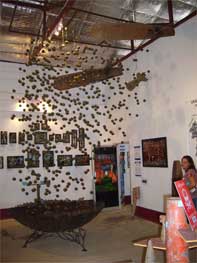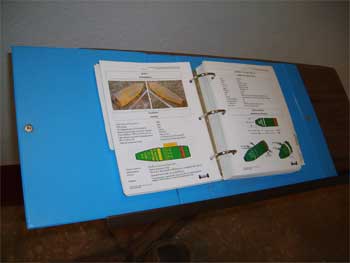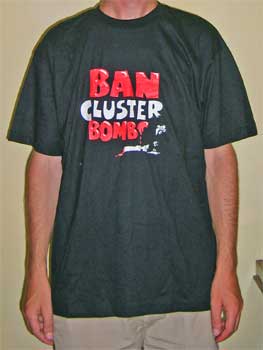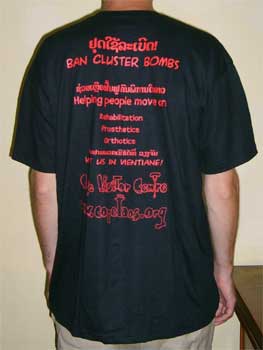Laos PDR: COPE Visitor CentreVientiane, Laos PDR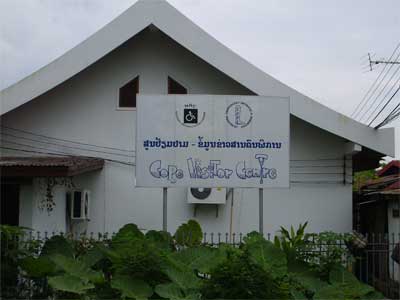 Sign marking COPE Visitor Centre The COPE (Cooperative Orthotic & Prosthetic Enterprise) works in partnership with Vientiane's National Rehabilitation Centre, and opened a plush exhibition in its Visitor Centre in August 2008. Hilary & I visited on 26 September 2008 - after noticing poster adverts in downtown Vientiane. The extremely enthusiastic and helpful bloke at the centre was a little disappointed that we hadn't seen the flyers he's been blitzing town with - still, if anyone finds this web page while Googling stuff to do in Vientiane, than we'd wholeheartedly recommend a trip to this exhibition. The COPE Visitor Centre exists to show how Laos helps amputees - many of whom tragically are still losing limbs to unexploded bombs left over from the massive and secret U.S. bombing campaign of 1964 - 1973 (during which they dropped more bombs on Laos than were dumped on Europe during WWII). A sculpture outside the entrance to the Visitor Centre was created from 500 kgs of metal from bomb casings and other ordinance, and is dedicated to the "memory of all those who were injured, lost lives and loved ones." 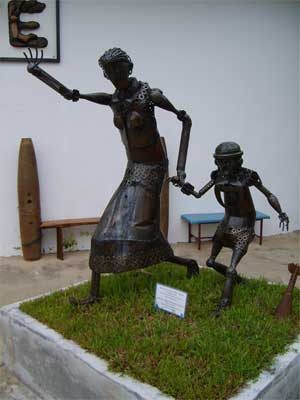 A sculpture outside the visitor centre's entrance. The first part of the one-room exhibition explains about UXO (unexploded ordinance) in Laos, with a little historical detail and examples of the type of bombs encountered - including a recreation of a cluster bomb in mid flight.
The next section explains the danger that buried UXO poses to farmers ploughing and hoeing their fields, and to children who mistake the tennis ball-sized bombies for toys. As in the Mines Advisory Group (MAG) exhibition we visited in Phonsavan, they also highlight the increasing danger that the high price of metal is causing - Laotians are now buying cheap Vietnamese metal detectors and actively seeking bomb metal to sell to Vietnamese scrap metal dealers (the trouble is, if you find a good large chunk of bomb metal there's a good chance it's still wrapped around live high explosives) A nearby display shows an actual scrap metal haul: 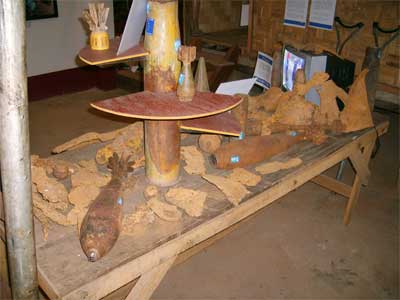 Bomb scrap collected in Laos. Spread around the exhibition are case studies of people treated by COPE, including this one about 'Ta':
In a nearby recreation of a traditional Lao house, a recording of a BBC World Service programme about UXO in Laos played on a look (broadcast on the 13th of June 2008). The contents of the house show how Lao blacksmiths create all sorts of household goods and tools from the good quality bomb metal ("The finest Detroit steel", as an expert in the radio programme dryly comments). Another concern is that children become accustomed to seeing recycled bombs around the house (such as oil lamps made from 'pineapple' bombs) and don't realise the danger of UXO. The house featured a bomb-awareness poster aimed at children: 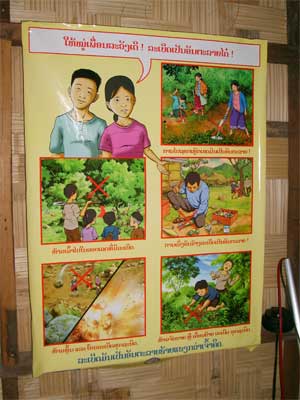 A Lao bomb-awareness poster. Whereas the MAG exhibition in Phonsavan went on to detail how MAG teams disarm UXO, the COPE exhibition detailed how they rehabilitate amputees. They mention that they don't just deal with bomb-injured people, but those with deformities resulting from leprosy or club foot, as well as those severely injured in road accidents. One exhibit shows how they construct prosthetic limbs for patients, with models showing the various stages of manufacture. Another exhibit shows the 'steps and bridge' used to help patients become accustomed to their new legs. 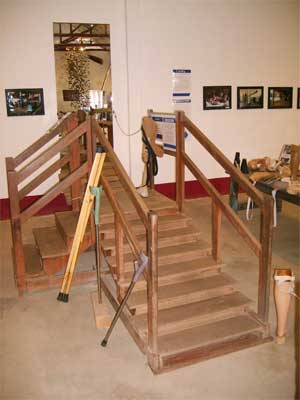 The steps and bridge COPE uses during rehabilitation. Another exhibit shows a variety of home made legs, used by people before they learned about the COPE project, as well as worn-out prosthetics returned from previous patients (a leg generally last for 2 years, or 4-6 months for a growing child) 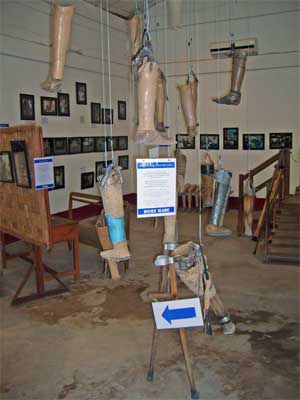 Home made, and worn out legs. A television, decorated with a mountain of prosthetics, plays videos in which patients fitted with prosthetic limbs describe how they were injured, and how they are coping with their new limbs. 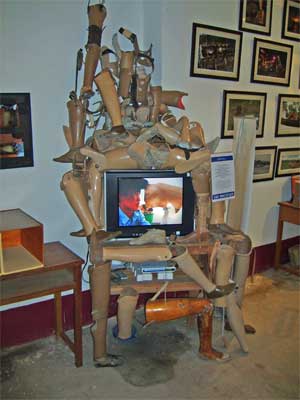 Video stories of COPE patients. Another great feature of the exhibition is the video room (modelled to resemble a Vieng Xai cave) in which you can choose to watch four documentaries:
'Bombies' was a very good film (once we got used to the dramatic voice-over). 'From Laos to Lebanon' was made to chart the forty years of the use and evolution of cluster bombs: from the U.S. bombing of Laos in 1964-1973, to the Israeli bombing of Lebanon in 2007. It focused on the arms manufacturers claims that they have reduced the percentage of bomblets that fail to detonate on impact from around 30% (Laos) to 2% (Lebanon), but shows that auto-destruct mechanisms don't work as planned, and unexploded bombs still injure civilians in the "post conflict" stage. Finally we had a look around the small shop area, where all sorts of things are for sale, to support COPE's work. I picked out a 'Ban Cluster Bombs' T-shirt:
Getting there and awayThe COPE Visitor Centre is a little out of town, along Th Khu Vieng past the Talat Sao Bus Station, then past a huge swimming pool/water park complex, and it is opposite the walled Green Park Hotel. In the end Hilary and I walked there and back (stopping for coffee at a JoMa Bakery in the waterpark on the way, and lunch at a nearby restaurant on the way back). Links
By Eoghan: |
|||||||||||||||||||||||||||
